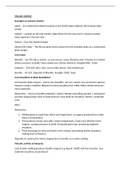Summary
Summary Advanced Geography A level Hazardous Environments - Nearly everything you need to excel
- Course
- Institution
The document includes notes on pretty much everything you will need to know on the Hazardous Environments topic for CIE geography. Complete with both summary notes and facts, examples and statistics needed for the highest possible marks on essay questions. NOTE - DOESN'T YET INCLUDE INFORMATION ON ...
[Show more]



